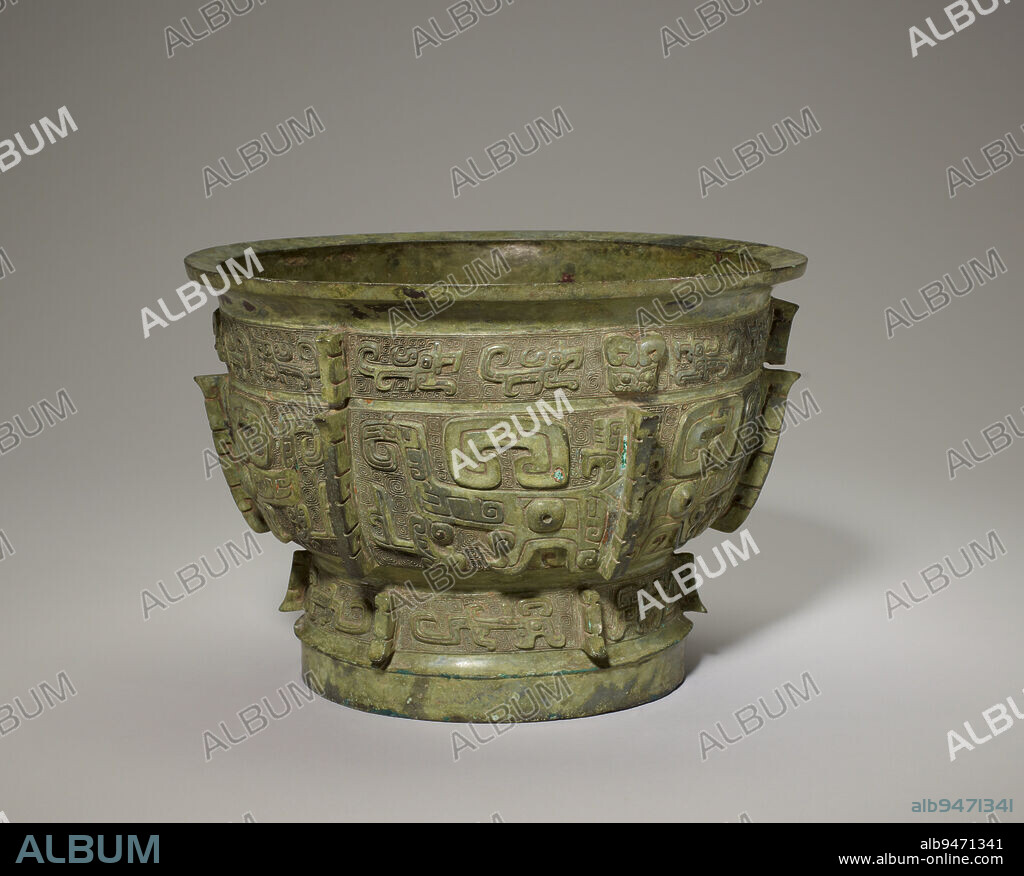alb9471341
Gui food vessel, 12th century BCE, 7 × 9 15/16 in., 8.8 lb. (17.8 × 25.3 cm, 4 kg), Bronze, China, 12th century BCE, Stylized animal motifs predominate Shang bronze decoration. The dragon, snake, cicada, ram, owl, tiger, and even elephant all make appearances. Yet these creatures were almost always less important than the taotie (composite animal) mask, which typically dominates the largest or most important register of nearly all Shang bronzes. This exquisite food bowl, an early form of the gui with looped handles that became prevalent particularly in the Western Zhou dynasty, has three such masks clearly cast in high relief encircling its cauldron. Below each mask, in the foot band, are two opposing dragons shown in profile, while four similar dragons appear above each mask in the top decorative band. The exact meaning of the taotie mask is unknown. A nine-character inscription cast on the interior bottom may stand for branches of a big clan.

|
Add to another lightbox |
|
Add to another lightbox |



Caption:
Gui food vessel, 12th century BCE, 7 × 9 15/16 in., 8.8 lb. (17.8 × 25.3 cm, 4 kg), Bronze, China, 12th century BCE, Stylized animal motifs predominate Shang bronze decoration. The dragon, snake, cicada, ram, owl, tiger, and even elephant all make appearances. Yet these creatures were almost always less important than the taotie (composite animal) mask, which typically dominates the largest or most important register of nearly all Shang bronzes. This exquisite food bowl, an early form of the gui with looped handles that became prevalent particularly in the Western Zhou dynasty, has three such masks clearly cast in high relief encircling its cauldron. Below each mask, in the foot band, are two opposing dragons shown in profile, while four similar dragons appear above each mask in the top decorative band. The exact meaning of the taotie mask is unknown. A nine-character inscription cast on the interior bottom may stand for branches of a big clan.
Credit:
Album / quintlox
Releases:
Model: No - Property: No
Rights questions?
Rights questions?
Image size:
6557 x 5270 px | 98.9 MB
Print size:
55.5 x 44.6 cm | 21.9 x 17.6 in (300 dpi)
Keywords:
12TH CENTURY BCE • 8.8 LB • ALMOST • ANIMAL: SNAKE • APPEARANCES • ARTFORM: BRONZEWORK • BIG CLAN • BRANCH (TREE) • BRONCE • BRONZE BRASS • BRONZE • BRONZES • CAST • CAULDRON • CHARGE • CHINA • CHINE • CHINESE • CICADA • COMPOSITE ANIMAL • CREATURES • DRAGON • DRAGONS • EARLY FORM • EVEN ELEPHANT • EXACT MEANING • EXQUISITE FOOD BOWL • FOOT BAND • FOUR • GUI FOOD VESSEL • GUI • HARVEST FLY • HIGH RELIEF ENCIRCLING • IMPORTANT REGISTER • INTERIOR BOTTOM • JARFLY • LAMB • LARGEST • LESS IMPORTANT • LOOPED HANDLES • MASCARA • MASK • MASKS • NEARLY • NINE-CHARACTER INSCRIPTION CAST • OWL • PORCELAIN • PREVALENT PARTICULARLY • PROFILE • RAM (ANIMAL) • RAMA • REPTILE: SNAKE • SHANG BRONZES • SHEEP • SNAKE SNAKE • SNAKE • SNAKES • STAND • STYLIZED ANIMAL MOTIFS PREDOMINATE SHANG BRONZE DECORATION • TAOTIE MASK • TAOTIE • THREE • TIGER • TOP DECORATIVE BAND • TWO OPPOSING DRAGONS SHOWN • TYPICALLY DOMINATES • WESTERN ZHOU DYNASTY • YET
 Pinterest
Pinterest Twitter
Twitter Facebook
Facebook Copy link
Copy link Email
Email

